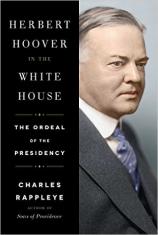Herbert Hoover in the White House: The Ordeal of the Presidency
Review
Herbert Hoover in the White House: The Ordeal of the Presidency
A doorstopper of a book on Herbert Hoover’s presidency –-- arguably four of the worst years in U.S. history --- has just arrived, and it will be applauded by those interested in the parallels between those times and our own recent recession. Interestingly, comparisons between partisan infighting and mudslinging might also be made. But what will intrigue those who thought they knew what Hoover was like is how complex a man he really was, and how often he got close to a revolutionary solution to economic ills, only to second guess himself or those around him.
It’s always a problem for a biographer coming to terms with how he or she feels about the subject at hand: Growing disdain is obviously worse than sustained admiration, but usually there’s a mixture of both. Charles Rappleye, author of three previous biographies, veers between the two, with exasperation toward Hoover being most frequent.
Somewhere in the last half of the book, as 1931 rolled around with no improvement in the economy, he vents: “…none of Hoover’s industry and none of his spirit of policy initiative came across to the public. The president’s penchant for secrecy, his spite for the press, and his overriding feat that disclosure of the difficulties facing the nation would only make things worse, meant the Hoover White House operated as the political equivalent of a black hole, a collapsed star that allowed no sound or light to escape its gated premises.”
"Rappleye does a great service by explaining the politics of the Great Depression and the role that Hoover played for better and, most definitely, for worse."
Hoover was something of a hero when first elected to the presidency. Known as “The Great Humanitarian” because of his work on the Wartime Food Administration and the American Relief Administration in World War I, he also organized a massive relief effort for victims of the Mississippi Flood of 1927. In 1928, he accepted the Republican party nomination, won a decisive victory against Al Smith, and was sworn in as the 31st President in 1929, in front of 75,000 people.
But events --- and his own personality --- conspired against him. In October, the stock market crashed, but Hoover, busy talking to bankers, took days to make a public statement. He was reluctant, and remained so for several more years, to move away from the model of private charities like the Red Cross supporting starving citizens. He vacillated on the issue of monetary easing and never gave up on the gold standard, despite most of Europe relinquishing it. On several occasions, he torpedoed Democratic initiatives --- even when he agreed with the underlying policies. He spied on rivals, undercut colleagues and ignored his constituents.
One of the worst public relations mistakes he made was to allow Douglas MacArthur to rout a group of army veterans who marched to Washington to demand they be paid a bonus promised by the government. When MacArthur used excessive force, Hoover never reprimanded him, instead taking the blame on his “broad shoulders,” as he told the general he would do.
The entrance of FDR as the Democratic candidate changes the tenor of HERBERT HOOVER IN THE WHITE HOUSE, just as it did the views of the citizenry. Suddenly, hope abounds. In the general election of 1932, FDR won 57.4% of the popular vote and 472 electoral votes. At the inauguration, the new President gave his famous “nothing to fear” speech, and the author says it was so rousing that it could be heard by the 150,000 attendees.
Rappleye does a great service by explaining the politics of the Great Depression and the role that Hoover played for better and, most definitely, for worse. Again and again, he describes the White House as a “gloomy place…under Hoover’s glower.” Understandably, that gloom permeates the book, making us long for FDR’s entrance so that he can rescue our poor, desperate forbears --- and the exhausted reader.
Reviewed by Lorraine W. Shanley on May 27, 2016
Herbert Hoover in the White House: The Ordeal of the Presidency
- Publication Date: May 10, 2016
- Genres: History, Nonfiction, Politics
- Hardcover: 576 pages
- Publisher: Simon & Schuster
- ISBN-10: 1451648677
- ISBN-13: 9781451648676





